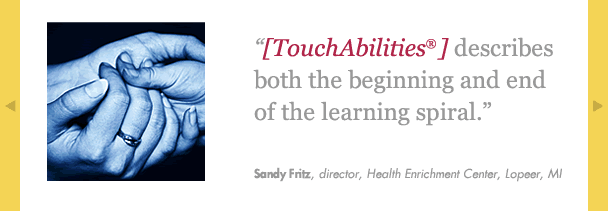components

WHAT IS TOUCHABILITIES?
COMPONENTS
Breathing Component:
The breath is a carrier wave of aliveness, movement and flow. The mechanics of breathing involve muscles, tissues and organs. The movement of these structures during breathing creates waves that impact every system of the body. This impact translates to pulsation, excitation, movement, vitality, motility and connection. There are 3 primary skills that can be applied when using the breath as a therapeutic tool: Tracking, Directing and Pacing.
Cognitive Component:
Thought waves and mental images carry ideas, information and intentions. Practitioners communicate and interact using these waves and images to affect the body. Mental processes can create change on a cellular level and profoundly impact overall health. There are 5 primary skills that can be applied when using the mind as a therapeutic tool: Visualizing, Inquiring, Intending, Focusing and Transmitting.
Energetic Component:
Energy skills link us with the vibratory waves that animate the body and all its systems. Energy is the carrier wave of life force and is expressed in matter through the vitality and motility of structure. Matter and structure have unique oscillation patterns of tangible and intangible frequencies, rhythms, states, cycles and pulses. There are 3 primary skills that can be applied when using energy as a therapeutic tool: Sensing, Intuiting and Balancing.
Compression and Expansion Components:
Compression and Expansion represent the carrier waves of centripetal and centrifugal force. Compression skills move matter and energy towards the core of the body while Expansion skills draw matter and energy away from the core of the body. These components are complementary and integral to one another and are an example of how totally different ways of “handling” the body elicit similar results and responses. There are 3 primary skills for Compression (Pressing/Pushing, Squeezing/Pinching, Twisting/Wringing) and 3 primary skills for Expansion (Pulling, Lifting and Rolling) that can be applied when using these Components as therapeutic tools.
Kinetic Component:
Kinetics is an umbrella term for a collection of skills that focus on movement relationships in the body. On a continuum from stillness to the edge of a client’s range of motion, whether active, passive, resistive or assistive, one can assess the state of a joint and its surrounding tissues as well as client attitude and receptivity to touch and support. There are 4 primary skills that can be applied when using Kinetics as a therapeutic tool: Holding/Supporting, Mobilizing, Letting Go/Dropping, and Stabilizing.
Oscillation Component:
Everything vibrates and is connected and related to everything else. All matter exists as an expression of, and is distinguished by, its unique oscillatory pattern, its vibratory signature. Practitioners use waves as signals and patterns of information that affect every system and every aspect of the body such as digestion, respiration, circulation, thought, emotion, etc. There are 3 primary skills that can be applied when using oscillation as a therapeutic tool: Vibrating, Shaking and Striking.
Gliding Component:
Gliding skills affect the tangible and intangible physical and energetic aspects of the body by engaging structure, shape, form, texture, density, temperature and contour as well as subtle dimensions of chi, thermal variation, wave patterns and biomagnetic attraction/repulsion. These skills can be applied with intent to lubricate, heat, separate, smooth, direct, sculpt, soften and/or nurture. There are 2 primary skills that can be applied when using gliding as a therapeutic tool: Sliding/Planing and Rubbing.
